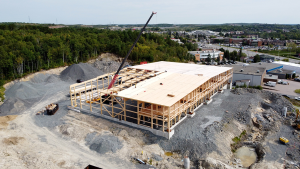Interest in mass timber construction (MTC) is growing, due largely to wood’s inherent ability to embody carbon. This in turn is allowing MTC to become more cost-competitive against traditional steel and concrete in project-specific applications. That’s good news for the environment.
However, concrete isn’t going anywhere. It remains a fundamental raw material for global economic development, the modernisation of cities and the construction of new infrastructure. By 2060, global construction is projected to add nearly 2.5 trillion square feet of floor space, much of it using concrete.
According to London, U.K. think tank Chatham House, the concrete industry is estimated to be responsible for as much as eight per cent of global annual emissions. If the concrete industry was a country, that would rank it third in total emissions behind the U.S. and China.
Several state, county and municipal jurisdictions in the U.S. have recently passed mandates requiring low-carbon concrete in their public works projects or building codes. Some require third party product verification.
These environmental and political pressures are motivating concrete manufacturers to improve the energy-efficiency of their production processes and to reduce their GHG outputs.
The concrete manufacturing industry is responding to these challenges on a global scale. In a recent media release, Jamie Gentoso, CEO, US Cement, Lafarge Holcim Ltd., spoke of the industry’s need to commit to reduced carbon emissions. “I truly believe that concrete is the best and most durable building material, but our industry must work to find ways to minimize our impact on the environment.”
Although only representing 10 to 20 per cent of concrete’s mass, cement has become the prime focus of carbon emission reduction efforts associated with concrete production. According to a survey of Portland Cement Association members, an average of 927 kg of CO2 is emitted for every 1000 kg of portland cement produced.
Fly ash, blast furnace slag and silica fume, waste by-products previously sent to landfills, have been used in combination with portland cement to the strength and durability of concrete. However, fly ash experienced a reported 11 per cent year-over-year production drop in 2018, due in part to the closure of coal-burning power plants across North America.
Further improvements will therefore likely require a new level of product development. For example, the recent investment by Bill Gate’s venture fund has given prominence given to Canada’s own CarbonCure Technologies for its patented process to embody collected third party carbon into the concrete mix.
Other new energy efficiency and carbon-capturing technologies are also on the horizon.
Four of Europe’s leading cement producers — Germany’s HeidelbergCement, Dyckerhoff AG and Schwenk Zement KG, plus Paris-based Vicat SA — have partnered in a 100 per cent carbon capture and storage (CCS) plant scheduled to open in 2020 in southern Germany. Dubbed “catch4climate”, the partnership has been investigating the use of oxygen fuel technology to maximize carbon dioxide capture in Portland cement production. It is suggested that oxygen, in lieu of ambient air, will result in a CO2 purity level that will permit the 100 per cent, cost-effective capture of carbon, thus allowing its subsequent use as raw material in other industrial processes.
In North America, Blue Planet of Los Gatos, CA and utility infrastructure specialist Kamine Development Corporation have teamed up to deploy Blue Planet’s mineralisation technology. The pair plan to convert power plant carbon dioxide emissions into a concrete-grade, synthetic limestone to offset the emissions associated with portland cement production. The carbon neutral (or negative) synthetic limestone aggregate will have the same structural characteristics and integrity as mined geological limestone and deliver the same performance when added to concrete.
Future innovations are expected from Innovandi, a research initiative created by the Global Cement and Concrete Research Network (GCCA). “Innovandi ties together the cement and concrete industry with scientific institutions to drive and support global innovation with actionable research and builds on the industry’s long-held commitment to ensuring a sustainable future,” says the GCCA.
John Bleasby is a Coldwater, Ont. based freelance writer. Send comments and Inside Innovation column ideas to editor@dailycommercialnews.com.








Recent Comments